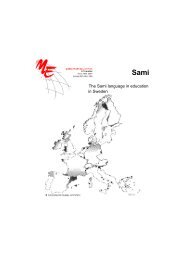Multilingual Early Language Transmission (MELT) - Mercator ...
Multilingual Early Language Transmission (MELT) - Mercator ...
Multilingual Early Language Transmission (MELT) - Mercator ...
You also want an ePaper? Increase the reach of your titles
YUMPU automatically turns print PDFs into web optimized ePapers that Google loves.
intergenerational transmission occurs by, for example, interventions with parents, health<br />
visitors, midwives, as well as by language learning in school, adult language classes, and<br />
literacy” (Baker 2003: 101). The <strong>MELT</strong> project and its products individually aim to make a<br />
contribution in encouraging parents to make a well-informed choice and practitioners to<br />
advise those parents as well as to guide the children on their way of a multilingual<br />
development.<br />
Traditionally a number of reasons are mentioned for the transmission of minority languages:<br />
pedagogical motivations, cultural values, diversity of society and language maintenance.<br />
First and most important of all, however, is the right of every child to become literate in<br />
their true mother tongue, as declared in the Universal Declaration of Children’s Rights. It is<br />
well known and often proven that the child’s chances of further cognitive development are<br />
most completely guaranteed by a good knowledge of the mother tongue. This universal right<br />
to mother tongue development, however, is much less accepted and less self-evident for<br />
children in bilingual contexts and / or in families where non-national languages are spoken.<br />
That situation, and in particular the aim of language development and maintenance requires<br />
special measures in terms of infrastructure or provisions, and training programmes. These<br />
aspects of language policy can help to fulfil the goals which are formulated for Welsh<br />
children, but are of equal importance for all children living in a multilingual society: “For all<br />
children, the essential aims of bilingual education in Wales should be: to develop community<br />
fluency in the Welsh and English languages; to develop biliteracy in the Welsh and English<br />
languages; to become multicultural and increasingly multilingual; and to have entitlement to<br />
equal access to the potential economic and employment benefits of bilingualism” (Baker<br />
2003: 104).<br />
6.2 Development of smaller state and regional & minority languages in<br />
education<br />
The position of minority languages in education and the formulation of aims and goals shows<br />
a development which can be characterised with the metaphors of stumbling stone, stepping<br />
stone and corner stone. For a long time, regional minority languages were, and nowadays<br />
immigrant languages still are, often considered stumbling stones which prohibit the children<br />
from acquiring a sufficient knowledge of the standard language and their full academic skills<br />
of reading and writing. Educational programmes used to neglect those languages, they didn’t<br />
even use those languages as an assistant or support tool towards the learning of the<br />
standard language. Later on, and also nowadays in some cases, both regional and immigrant<br />
minority languages are being used in the starting phases of oral language development and<br />
early literacy, but forgotten as soon as the serious aspects of education begin, in particular<br />
teaching of reading and writing skills. This phase of transitional education can be<br />
characterised as the stepping stone towards the mastery of the dominant language(s).<br />
The position of the corner stone means that both the minority language and the dominant<br />
language are taught and learned on equal footing, aiming at “full bilingualism, biliteracy”<br />
(Fishman) at the end of obligatory school attendance. This position of equal corner stones<br />
can be achieved only on the base of a number of conditions and measures, in particular<br />
continuity of schooling and learning, starting from pre-school through primary school to<br />
secondary education. The continuous development of bi- and multilingual children towards<br />
the achievement of all language skills (listening, reading, speaking and writing) on the level<br />
which is appropriate to the reference age of the children is often a challenge.<br />
80



